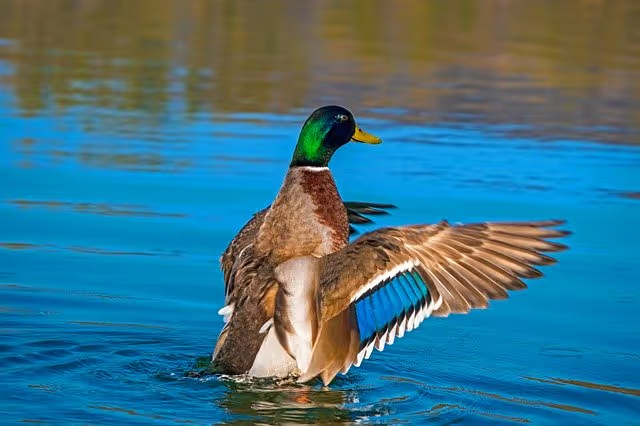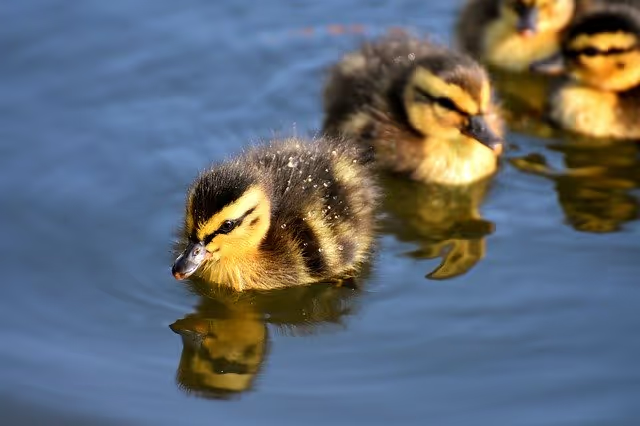Magnificent Mallard Ducks



Mallard Ducks are possibly the most familiar duck species in existence. If you have spent any amount of time outside, you've probably seen one or more of them. Male Mallard Ducks are the most readily identifiable ducks in existence, with their gray flanks, black tail-curls, and glistening green heads. They also have bright yellow bills. Their bodies are gray, with black rear and brown breasts. Females and juveniles aren't as easy to identify. Their bodies are mottled brown, and their bills are a combination of brown and orange. Both sexes of Mallards have a white-bordered, blue “speculum” patch in their wings. Mallard Ducks are large, with rounded heads, hefty bodies, and flat, wide bills. Their bodies are long, and their tails are most often riding high out of the water. This gives the ducks a blunt shape. When they are flying, their broad wings are set back toward the rear of their bodies. Mallard Ducks are very strong fliers, with flocks of migrating ducks being estimated to travel at up to fifty-five miles per hour.
Mallards are “dabbling ducks”. This means that, instead of diving for food, they feed in the water by tipping their bodies forward and grazing on underwater plants. They can be very tame, especially when living in city ponds. In fact, they are so tame that they will often group together with not just other Mallards, but with other species of dabbling ducks as well. While female Mallards have the same quack as most other species of ducks, male Mallards don't quack at all. Instead, they make a quieter, rasping sound.

Mallard pairs begin forming well in advance of the traditional spring breeding season. The pairs are typically monogamous. Pairing normally occurs in the fall, but courtship can be seen happening throughout the winter months. Like other duck species, Mallards shed all of their flight feathers at the end of each breeding season. This means that they cannot fly for up to a month, making them vulnerable to animal predators and human hunters. However, they aren't completely defenseless because their body feathers molt into a “eclipse” plumage that conceals their true identities.
In the fall and winter months, Mallard Ducks stick to a predictable daily routine that not only provides them with food to eat, but preserves the wetlands they call home. They spend their nights foraging, flying from one patch of wetland habitat to another in search of stems, roots, and seeds to eat. They effectively treat the landscape "as one big buffet." By eating seeds in one spot and pooping them out in another, sometimes up to five miles away, they "knit together islands of habitat" that would not otherwise be linked to each other. Without Mallards and other ducks doing their nightly rounds, plant seeds from one area would not be able to reach the next area. This means that these small wetland fragments remain isolated and become susceptible to "local extinction." In this way, the ducks help to maintain existing patches of healthy plant communities in a world where wetlands are disappearing and fragmenting every day.
When morning comes, Mallard Ducks return to their roosts for a day of rest. During this time, they socialize, sleep, preen, and poop out any seeds that they ate during the night. One-third of these defecated seeds end up back at the ducks' roost, while only seven percent of those seeds remain at the ducks' temporary foraging areas. If the growing conditions are favorable, those seeds will sprout and grow into new communities of plants. This means that, without even realizing what they are doing, ducks plant small botanical gardens containing cross sections of local plants at their roost sites. These gardens store a vault of genetic diversity to ensure that plant populations are able to be replenished even as the landscape continuously changes around them.

Mallard Ducks are capable of living in nearly any wetland habitat, be it natural or artificial. If there's water around, there are probably Mallards living in or near that water. You can find them swimming around in lakes, marshes, ponds, coastal habitats, and rivers. You can also find them in city and suburban parks, as well in some residential backyards. Because Mallard Ducks are able to live in so many different water-rich environments, they have been able to establish themselves around the world in large numbers. As a result, the species has paved the way for a number of smaller populations to grow and flourish. However, these populations have changed just enough from the original Mallard Duck species that they can reasonably be considered as their own species. For example, the Hawaiian Duck of Hawaii and the Mexican Duck of central Mexico are both closely related to the Mallard. In both forms, the male is dull, as are all female Mallard Ducks. The Hawaiian Duck currently has full species status while the Mexican Duck is considered a subspecies of the Mallard. Many species of waterfowl form hybrids, and Mallards are particularly well known for doing this. They have hybridized with several other duck species, including the with American Black Duck, the Pacific Black Duck of Australia, and the Grey Duck of New Zealand.
References
© Ian D. Caldwell, September 2020
Touch whale bones, examine shipwreck artifacts and connect with the coast's living history.

Support our mission, get involved in educational programs, or contribute through donations and volunteering.